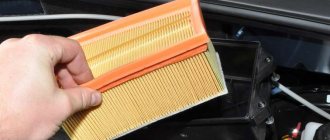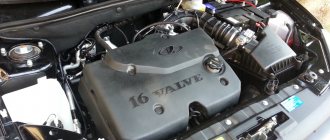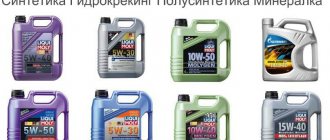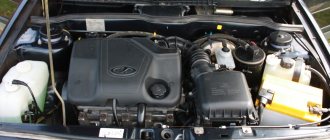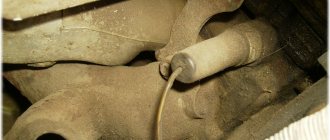Specifications
power 21129 (127) – 106 hp. (21126 – 98hp)
Torque 21129 (127) – 150 N.m (21126 – 145 N.m.) at 4000 rpm.
Mixed fuel consumption is 7-10 liters per 100 km. More details about fuel consumption
Recommended fuel – AI 95
Motor weight – 115 kg.
The table above shows the torque and power graph of the 1.6L 21129 engine and its comparison with the 21179 1.8L engine.
Oil
The oil used in this engine is similar to 21126: synthetic, semi-synthetic
5W-30 5W-40 10W-40 15W40
Oil sump volume
This point will be useful for those who are going to change the engine oil. With different transmissions, the volume of oil poured into the engine is also different.
VAZ 21129 + Renault manual transmission (cast crankcase) = 4.4l
VAZ 21129 + robot (stamped crater) = 3.2 l
The engine resource is 200 km. But in practice, you need to monitor the condition of the roller, pump and timing belt, because if individual valve elements jam, they will meet the piston group, and then both will come to an end. In addition, during the impact of these elements, it is not uncommon that the crankshaft bends slightly. You can drive with such a crankshaft, but there will be huge oil consumption.
About choosing a filter
The oil filter on the K4M engine must be changed at every oil change. This requirement is more stringent than for 8 valves. On an 8-valve engine, the filter can be replaced “every other time,” although this is contrary to the regulations. But the 16-valve engine is not ready for such “difficulties”.
Articles
The Renault catalog contains two designations - 7700274177 and 8200768913. These are the article numbers for oil filters. But they differ - the first, “shorter” filter comes from the factory.
Filters 7700274177 (left) and 8200768913 (right)
Filter housing height:
- 7700274177 – 49 mm;
- 8200768913 – 53 mm;
- 7700873603 – 55 mm.
You can try the third option at your own risk.
Selection of analogues
- VALEO 586001
- AMC MO441
- GoodWill OG-313
- MecaFilter ELH4196
- Logem LRT-328
- MANN W75/3
Show hidden content
- BASBUG BSV7700274177
- MAHLE OC467
- FEBI 27155
- FILTRON OP643/3
- BOSCH 0 451 103 336
- ASAM 30097
- FORTECH FO-018
- PATRON PF4032
- MEYLE 16-14 322 0000
- COOPERSFIAAM FT5902
- MFILTER TF 46
- UFI 23.418.00
- FRAM PH5796
- BLUE PRINT ADC42115
- PURFLUX LS932
- HENGST H11W02
- CHAMPION F136/606
- LYNXauto LC-1400
- CUMMINS HF7615 or LF3494 or LF3714 or LF798
- FORD 5013388 or 5006227
- DEUTZ-FAHR 12850312 or 1052175136
- LIGIER 112397
- NISSAN 15208-00Q0D (H/N/F)
- ALFA ROMEO 0073500506
- MAZDA AM1514302 (55 mm)
- Nevsky filter NF-1018
Features of 21129 engine/differences
The main feature of the 129 engine is the “innovative” for AvtoVAZ installation of an intake receiver with variable chamber geometry and volume. Due to the damper, the volume of the intake chamber changes depending on the speed. As practice shows, the damper is activated at 3500 engine speeds.
In addition, the engineers managed to get rid of the mass air flow sensor - mass air flow sensor. Along with him, his ailments went away, which tormented the owner of the 21126 engine: unstable idling, sometimes exorbitant consumption, high cost. Instead of mass air flow sensors, engineers installed a connection from DBP and DTV sensors (atmospheric pressure and air temperature sensors). This is where the differences from the 126 engine end. Speaking in fact, the intake system with variable geometry is as old as the world and has been installed by global manufacturers almost since the 80s.
Differences 21129 from 21126 (mounted layout, transition from mass air flow sensor to DBP+DTV, presence of an intake receiver with variable geometry.
Differences between 21129 and 21127 (Different layout, different firmware)
What oil is recommended?
To replace it yourself, you will need an inspection hole or overpass, a container for used oil and a set of keys. The replacement must be carried out with the engine warmed up to operating temperature. To do this, the engine is either warmed up at idle or replaced immediately after the trip.
To access the drain plug, the engine protection is removed. The plug is unscrewed with a size 8 hex wrench and a container for used oil is placed under the drain hole. The draining process takes at least 10 minutes.
After this, you should remove the old filter
. If it is not too tight, then it can be unscrewed by hand. If you can’t do it manually, you can use a special device. If this is not the case, a regular screwdriver will do. To do this, it is driven into the filter away from the engine and used to unscrew it as a lever. The new filter is lubricated with oil and installed on the engine. There is no need to tighten it too much.
It is enough to tighten it another 2/3 of a turn after the filter rubber ring comes into contact with the engine. Then you need to replace the drain plug. If the rubber gasket between the plug and the pan is damaged, it is replaced with a new one. In this case, you can use a copper gasket rather than a rubber one.
Engine tuning 21129
Tuning the 21129 engine is no different from the 126 engine.
Easy tuning : Euro-2 or Euro-2 firmware + installation of 4-2-1 exhaust
Medium tuning : Exhaust 4-2-1 + Shafts + firmware (preferably flashed online)
Deep : includes modification of the head, replacement of valves, pushers, etc. All technical characteristics of Vesta.
Other engines:
Lada Largus is a car jointly produced by the AvtoVAZ and Renault-Nissan concerns, which has several different modifications: Largus R90 - with 5 or 7 seats, F90 - a small cargo van and Cross in black and white. These cars operate on injection 8-valve and 16-valve internal combustion engines, which determines their power - 87 or 105 horsepower, and have environmentally friendly particulate filters and recovery catalysts. The fuel and lubricant is selected according to its characteristics. You can read about what kind of oil to fill into the Lada Largus engine in the documentation supplied with the car - for 16 valves and 8 valves the requirements will be slightly different.
Rules for selecting oil for the LADA Largus engine.
Lada Largus engine oil
The overall creation of a small car jointly produced by AvtoVAZ and Renault began in 2012. The model was developed on the Nissan B0 platform and intended for the Russian market as an adaptation of the Dacia Logan I (the Sandero, Duster and a whole generation of Nissan cars were created on the same platform). To adapt Largus to the peculiarities of Russian roads and climate, the unique suspension was changed and slightly updated with arches. For those people who don’t really delve into the technical data, Largus from the outside looks like our client remains the same Logan, topped with the AvtoVAZ logo familiar to everyone.
Initially, the production model is equipped with 1.6-liter 4-cylinder gasoline engines, expectedly borrowed from Logan. These are 8- and 16-valve units with a power of 86 and 102-105 hp. and with an average mixed fuel consumption of 7.2.7 and 8.4 liters per 100 km, respectively. Very affordable speed – up to 165 km/h and the model is positioned by the manufacturer specifically as a machine for performing work. Information about the types of oil to be filled is indicated below.
Lada Largus is available in several modifications. This is a cargo version of the F90, a passenger version of the R90 and Cross, characterized by increased ground clearance and a stylish interior. The car is an economical model, which, in general, is known for the quality of its assembly and good driving characteristics. However, its main advantage in the competitive struggle among small-class cars is its ability to transport large cargo thanks to a fairly capacious trunk. In addition, if necessary, Largus can be easily converted into a van (you only need to remove the rear seats, leaving only the front ones). He has the following significant feature that gaming slots have - the low price of almost all components of the machine, which makes repairs cheap and quick.
What kind of engine oil was filled in from the factory?
When you buy a new car from Largus dealers, Elf Solaris Rnx 5w30 synthetic all-season engine oil is already poured inside it (for moderate climates with summer temperatures no more than +25 degrees and winter temperatures up to -30). After purchasing a car, fuel and lubricants can be changed immediately or wait until the mileage reaches 15 - 30 thousand km. It is not necessary to use the exact oil for the Lada Largus that was filled at the factory - pay attention to other brands recommended by the manufacturer.
Oil change Lada Largus K4M.16kl
Another more fundamental question that interests many car owners is how much oil is in the engine? In contrast to the 8-valve unit, which requires 3.3 liters, the Lada Largus 16-valve unit fits 4.8 liters of lubricating water. So, if a car owner decides to change the oil on his own, then for the 16 valve K4M engine there is the option to safely take a 5 liter canister.
Let's look at the sequence and number of actions aimed at changing the engine oil in a Lada Largus engine with 16 valves:
- Let the car engine cool down.
- To carry out the following operations, access from below the vehicle is required.
- Unscrew the drain plug from the oil pan. In advance you need to substitute a 5 liter container. under the drain hole, and additionally remove the motor protection.
- When the oil is almost gone, of course, change the oil filter. Don’t forget that you need to lubricate the filter element in advance by pouring 150 grams of engine water into it.
- We tighten the drain plug, having previously replaced the o-ring.
- We unscrew the filler plug and begin to pour oil into the Largus engine.
- When the required volume is filled, it is worth warming up the engine for a couple of minutes. If the unit is turned off, it is worth checking the oil level in the engine using a dipstick. If necessary, add engine fluid to the required level.
The main type of modification of the unit today is chiptuning. This is a fairly common operation; there are a number of types. So, chip tuning may be aimed at increasing power or reducing fuel consumption.
On Lada Largus, soldering the chip should be trusted to experts, since carrying out the operation without the help of others leads to sudden and bad consequences. The procedure itself looks like a chip programmed to increase engine power is soldered into the electrical engine control unit. Later the ECU is flashed and the engine is ready for use.
Renault company recommendations
If you haven’t found Elf Solaris Rnx on sale or you’re not satisfied with the price, then choose one of those oils recommended by Renault to fill in your Lada Largus. These are brands such as:
- Shell PC 1448 0W30, PC 1021 0W30 - low-viscosity all-season oils (may need to be replaced with a more viscous lubricant if you live in a hot climate) on a synthetic basis, recommended only for 8-valve engines;
- ELF Solaris MSX 5W-30, ELF Excellium NF 5W-40, ELF Evolution SXR 5W40 – more viscous fuels and lubricants compared to the previous ones;
- Lukoil Genesis RN 5W40 is a domestic oil of moderate viscosity.
What and how to choose?
What kind of oil should I use? To select the correct oil, you will need to study the manual supplied with the car. Its pages display all the required characteristics and properties of the lubricant.
To replace, you will need to contact a dealer service station. If the car’s warranty period has already expired, then such a replacement can be carried out independently or with the help of service technicians. The procedure itself is not complicated and does not require any secret skills.
The system filter must be replaced at the same time as the oil. Based on the characteristics and properties of the lubricant regulated by the manufacturer, we can safely consider the following products:
- “Shell” with the following viscosity and temperature parameters “5W–40”;
- "Valvolin" with "5W-30";
- "Gulf Formula G", has the characteristics of "5W-40";
- "ZIC A+" with "10W–40".
Which oil to choose for a 16 valve engine
For 16-valve Lada Largus R40 and Lada Largus Cross, oils with the following characteristics are best suited:
- 0w30, 0w40 - for winter or harsh northern climates, where 0 is the range of permissible temperatures for “cold” engine starting, at which the oil does not harden and lubricates the parts well (in this case, up to -35 degrees), and 30, 40 - this is an indicator of low viscosity;
- 5w30, 5w40 - all-season fuels and lubricants for the temperate zone, where frost does not fall below -25 degrees;
- 10w30, 10w40 – for warm southern climates, where the temperature is not lower than -20;
- 15w30, 15w40 – summer option, for regions where the thermometer does not drop below -15.
These recommendations were compiled by AvtoVAZ experts without indicating brands and possible manufacturers. That is, we pour oil into the Lada Largus Cross and Lada Largus R40, where according to SAE the first digit is no less than 5 (for example, 5w30). 0W30 is not suitable for such cars
Motorists' choice
Sometimes motorists have a different approach to choosing engine oil for a Lada Largus car and, based on their experience, offer names that are not included in the list of recommendations:
- Lukoil Luxe SN 5W40 – all-season synthetics;
- Shell Helix Ultra 5W40 - unfortunately, in this case it is easy to buy counterfeit oil;
- ELF Evolution 900 FT 0W30 – for the Largus R90 model;
- Nissan Oil 5W40;
- GM Dexos 2 5W30.
The oil should not be too viscous, otherwise it will harden in the engine, and for Largus this is fatal, since minimal gaps are left between the parts. Now a little about how much lubricant is required per fill. The crankcase holds 5 liters. It is necessary to fill it with fuel and lubricants until it is full, also changing the filter (the last condition is important for 16-valve engines).
At the same time, the car is driven into a garage with a pit, the engine is warmed up, then the ignition is turned off, the crankcase is opened and the used lubricant is drained. The new filter is impregnated with fresh fuel, the rest is poured into the internal combustion engine and the engine is turned on to check using the indicators whether there is enough fluid. It is not necessary to carry out all the manipulations yourself - you can trust the service station workers, especially since getting to the crankcase in the Lada Largus is not easy.
What is important besides changing the lubricant in the engine and manual transmission
Many car enthusiasts do not like to look under the hood before changing the lubricant. The fact is that during operation, rubber gaskets and seals can harden and leak oil. As a result, lubricant loss begins in these devices. The level decreases, which leads to strange behavior of the car on the roads and ultimately to major repairs.
To prevent this from happening, experienced mechanics advise:
- every 5,000 kilometers check the lubricant level in the engine;
- Every 30,000 kilometers, check the oil level in the manual transmission.
Such simple measures will save the car owner from wasting money. If necessary, it is recommended to add oil to the gearbox or power unit. The engine and manual transmission are pre-serviced. A technical inspection is needed to detect faults that lead to loss of lubricant.
What harms the normal long-term operation of the rubber parts of the engine and mechanics:
- daily delays in traffic jams. The oil in the power unit and gearbox heats up and then cools down; the oil seals expand and contract at a constant frequency, which leads to their wear. And the lubricant itself quickly loses its properties in this case;
- starting the engine cold;
- Frequent travel over short distances. The liquid does not have time to really warm up. Condensation forms. This happens very often in winter.
And condensation dilutes the lubricant, and it loses its protective properties.
Engine oil change period Lada Vesta Cross
The frequency of changing engine oil for a Lada Vesta Cross car is every 10 thousand km or once a year, depending on how quickly the oil deteriorates. It is recommended to carry out a timely check of the condition of the fluid, and if signs of deterioration in the quality of the oil are detected (turbidity, the presence of wear products in the form of sediment, a burning smell, insufficient level), it must be changed every 6-7 thousand km. As a rule, this is usually relevant for urban use, when the car is stuck in traffic jams most of the time. In this case, sudden starts and braking are possible, leading to overheating of the engine.
Lubricant replacement procedure
The lubricant is replaced in a certain sequence. How much lubricant to prepare for this is indicated above. Depending on which engine (8 or 16 valves), the appropriate viscosity is selected. In addition, you must purchase a new oil filter from Renault catalog 7700274177 or 8200768913. You must also have the following materials available:
- container for draining waste substances;
- a set of keys, a filter remover;
- rags and brush;
- tetrahedron by 8.
Next, perform the following steps:
- The car is driven onto an overpass or inspection hole (the engine is warmed up).
- The engine crankcase protection is removed using wrenches.
- The oil pan is cleaned of dirt and other deposits.
- The hood rises and the plug opens, through which lubricant will then be poured.
- The tetrahedron loosens (a couple of turns) the drain plug.
- The container is inserted, the plug is completely unscrewed, and the used lubricant is drained.
- It is necessary to check the condition of the sealing gasket, which, together with the plug, closes the drain neck. If it is unsatisfactory, it will need to be replaced.
- After some time, after the waste material has completely stopped flowing, the neck plug is screwed back on.
- The filter is replaced - the used part is unscrewed using a puller. The rubber seal of the new filter is lubricated with oil, after which it is screwed into place.
- New working fluid is poured through the filler neck. Ideally, about 4.8 liters should enter, but no more. It is advisable to periodically check the level with a dipstick. After this, the neck is closed with a stopper.
- The motor starts and runs to circulate the lubricant throughout the system. When starting, the emergency oil pressure lamp in the engine should go out. After warming up, you need to check the lubricant level again with a dipstick. It should be halfway between the minimum and maximum.
Lada Largus is ready for further trips. You can watch the oil change procedure on video for a better understanding.
How much oil to fill in the Lada Vesta Cross engine
First generation, from 2018
Vesta Cross stands out for its sporty sedan silhouette with off-road plastic body kits, as well as larger wheels than the regular Vesta. In fact, all the changes made to the chassis are the same as those of the station wagon of the same name with the Cross prefix. The ground clearance is also more than 200 mm, which significantly increases maneuverability. At the same time, the model remains front-wheel drive even in the maximum configuration. But the interior of the Cross version has advanced equipment with original solutions characteristic only of this modification: these are seats with a combined finish (eco-leather, fabric and orange-gray inserts), an improved instrument cluster with special graphics and lighting (only for cross versions), driver's seat with lumbar support and height adjustment, multifunction steering wheel, on-board computer, full power accessories, climate control, 7-inch touch screen with navigation, etc.
Also read: Engine oil for Lada Granta engine
Gasoline engines from 2018
- 1.6 106 l. With. (21129), oil volume - 4.4 liters (or 3.2 liters - with AMT), tolerance and viscosity: API-SN; SAE 5W-40, 0W-40, 0W-30, 10W-40, 10W-30
- 1.8 122 l. With. (21179), oil volume - 4.4 liters, tolerance and viscosity: API-SN; SAE 5W-40, 0W-40, 0W-30, 10W-40, 10W-30
Brief excursion
In numerous videos presented on the Internet, you can see this car, get acquainted with its characteristics and watch test drives. The spacious interior and large trunk are impressive, which is very useful for Russians - especially those who like to travel outside the city.
In 2010, Lada Largus was first presented to the public. After 2 years, the first car rolled off the assembly line and industrial production began. The car itself is a copy of the Dacia Logan MCV, presented under license for production at AvtoVAZ. Nowadays, several modifications of the Lada Largus are produced: with a station wagon body capable of accommodating 5 or 7 passengers, as well as with an all-metal body and a 2-seater saloon.
The car is equipped with two French injection engines with a volume of 1.6 liters - with 8 valves and a capacity of 87 hp. s., as well as a 16-valve engine with a capacity of 105 horses. A 16-valve engine has two camshafts, an 8-valve engine has one. The car is made on the Renaul Logan platform, and the engines are also taken from there. Transmission – manual 5-speed, French.
In the video you can see how the Lada Largus confidently moves along our roads. This became possible because the suspension, springs and shock absorbers are adapted to Russian road conditions and are designed for increased load capacity. Increased ground clearance also contributes to good cross-country ability.
What oil to use for the Lada Vesta Cross engine
Original
The manufacturer of the Lada Vesta Cross recommends synthetic motor oil of varying degrees of viscosity. Viscosity is selected based on temperature and climatic conditions. For example, for year-round use, a viscosity of 10W-40, 10W-30 or 5W-40 is suitable. In summer, you can choose 20W-40 or 25W-50, and mainly in cold weather, winter oil 0W-30, 0W-40 or 5W-30 is suitable.
Unoriginal
Owners of Lada Vesta Cross cross-sedans should opt for inexpensive motor oils from domestic brands Lukoil, Rosneft, G-Energy and Gazpromneft. Of course, you can prefer higher quality imported lubricants. When choosing a compatible oil, it is necessary to take into account the API approval, which is selected depending on the year of manufacture of the car, as well as the type of internal combustion engine. For example, for the petrol Vesta Cross 2021. and later all-season synthetics with a viscosity of 10W-40 and API-SN approval are suitable. Below are the best options for analogue motor oils for Lada Vesta Cross:
- Shell Helix Ultra 5W-40
- Lukoil Genesis 5W-40
- Liqui Moli 5W-40 Optimal Synth
- Motul 8100 5W-40
- Mobil Super 3000 5W-40.
